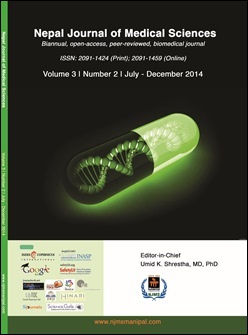Sutureless hemorrhoidectomy vs open hemorrhoidectomy: a prospective study in a regional hospital of Western Nepal
DOI:
https://doi.org/10.3126/njms.v3i2.13456Keywords:
Hemorroidectomy, ligasure, open, suturelessAbstract
Background: The aim of this study is to compare sutureless Hemorroidectomy with Conventional Open Hemorrhoidectomy in terms of safety and clinical efficacy.
Method: A prospective analytical study of 60 operated patients (a nonrandomized cohort) was carried out by following up from admission to 1 month period after hospital discharge in between July, 2013 to February, 2014 in Western Regional Hospital, Pokhara, Nepal. Demographic data, clinical data, mean operation time, duration of hospital stay, number of parenteral analgesic injections and post-operative complications between the two groups were recorded and analyzed.
Result: There were no statistically significant differences between the two groups in terms of age, gender, duration of symptoms, grade of the hemorrhoid(s), or number of hemorrhoids resected. The mean operating time for LigaSure sutureless hemorrhoidectomy was significantly shorter than that for the Open hemorrhoidectomy (P < 0.001). Patients treated with the LigaSure technique had less blood loss, a better pain score (P < 0.001), less parenteral analgesic requirement (P < 0.001), shorter hospital stay (P < 0.001), and early return to work (P < 0.01).
Conclusion: Sutureless Technique is safe and effective as compared to Conventional Open Hemorrhoidectomy for grade III and IV hemorrhoids.
Nepal Journal of Medical Sciences Vol.3(2) 2014: 121-123
Downloads
Downloads
Published
How to Cite
Issue
Section
License
Copyright © by Nepal Journal of Medical Sciences. The ideas and opinions expressed by authors of articles summarized, quoted, or published in full text in this Journal represents only opinions of authors and do not necessarily reflect the official policy of Nepal Journal of Medical Sciences or the institute with which the author(s) is (are) affiliated, unless so specified.




